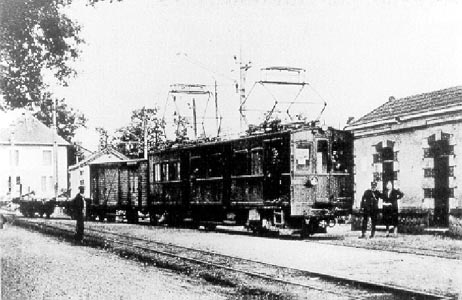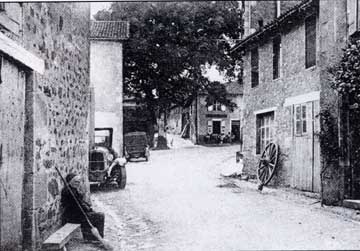Oradour-sur-Glane Tram

The photo above shows the tram at the
passenger station, which is shown on the right. The main tram
track is in the foreground; the tram is on the sidetrack in front
of the station. The tram station is located in the Upper Town
at the northern end of the main street, Rue de Emile Desourteaux.
Sarah Farmer wrote the following description
of the tram in her book entitled "Martyred Village":
Five trams a day ran in each direction
from Limoges to St.-Junien, with a stop in Oradour. The trip
from Limoges to Oradour took a little over an hour. On Saturdays
during the war years, residents of Limoges came by tram to provision
themselves with meat and other items that were in short supply
in the city. The Limogeauds often made the trip into a day's
outing, spending the morning shopping and then taking the afternoon
to picnic or fish on the banks of Glane, which passed under a
bridge at the southern entrance to the town.
While the SS soldiers were in the midst
of destroying the village, a tram arrived from Limoges and was
stopped before it crossed the river Glane. The 22 residents of
Oradour-sur-Glane, who were returning home, were taken off the
tram, but not the other passengers. The Oradour residents were
held for two hours and then told that they were free to go. One
young girl was given a bicycle by one of the soldiers so that
she could leave faster. The tram returned to Limoges, arriving
around midnight.

The photo above shows the bridge over
the Glane river. On the extreme left is the church with its spires
still intact. Women in the village are washing their clothes
on the banks of the river.
In her book entitled "Martyred Village,"
Sarah Farmer gives the following description of Oradour-sur-Glane:
In the interwar period, Oradour was
also a lively center of sociability. There were numerous cafes,
three musical clubs, a soccer team, and two veterans' associations
from the Great War. On Sundays, clubs from Limoges would come
by tram to spend the day on the banks of the Glane, where they
organized fishing contests. Commercial and social connections
created a tightly knit extended community. Local farmers came
into Oradour to conduct all manner of business. Their wives ventured
into town less frequently but could be seen on the semimonthly
market days going to the local grocer, or sometimes stopping
at the fabric shop of Monsieur Dupic in the main street. The
commune's elementary schools were in town, so many children from
outlying hamlets walked into Oradour to go to school.
The photo below shows the intersection
of the main street, Rue de Desourteaux, with the Les Bordes road.
The tree in the background is the Tree of Liberty, planted in
1848, a time when there were left-wing revolutions throughout
Europe. To the right of the tree in the background is a building
that was called the Oak cafe when this photo was taken. At the
time of the massacre, this was the Milord Cafe and Hotel. The
car in the photo appears to be a model that was manufactured
in the early 1930ies.


The photo above shows Les Bordes road
at the intersection of the main street, as it looks today. Note
the tree that is still there.
|